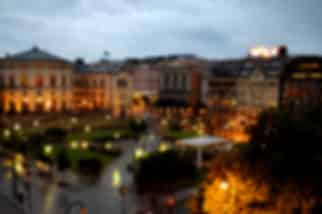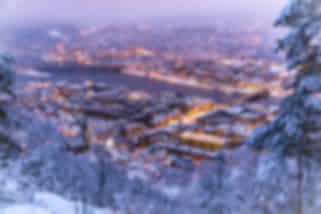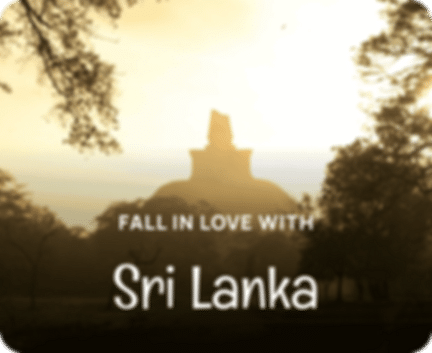Norway in March : Complete Travel Guide to Weather, Northern Lights & Best Things to Do
Author
Raj Kumar Bora
Updated Date
November 24, 2025
Read
8 minutes

Are you planning to visit Norway in March? Norway in March is a transitional period from winter to spring. The month is characterised by longer daylight hours, a picturesque landscape dotted with snow-covered mountains and a mix of winter and early spring conditions. This shoulder season offers significant cost savings as compared to the peak summer months, thereby making it the best time to visit Norway for budget travellers. Whether you are chasing the Northern Lights in Tromso, skiing the Olympic slopes in Lillehammer or exploring the fjords, Norway in March provides diverse experiences without the high-season crowds.
Key Takeaways:
- Perfect Timing for Northern Lights: March offers your last chance to see the Aurora Borealis before the season ends in April, with clear skies and extended darkness hours above the Arctic Circle.
- Off-Season Advantages: Experience 30-40% lower costs on flights and accommodations compared to summer peak season, with fewer crowds at major attractions and ski resorts.
- Extended Daylight Hours: Enjoy 10-12 hours of daylight in southern Norway (Oslo, Bergen) for sightseeing, while northern regions still maintain darkness for Aurora viewing.
- Winter Sports Peak Season: March is ideal for skiing with the best snow conditions of the year, plus major festivals like the Holmenkollen Ski Festival and the Birkebeiner Race.
- Budget Range: Expect Rs. 1,25,000-2,50,000 per person for a 7-day trip, including flights, accommodation, activities, and meals.
Norway Weather in March: Regional Forecast & Temperatures

Weather Overview: What to Expect in Early Spring
Norway in March is a transitional period and the weather patterns vary significantly between the southern cities and the Arctic regions.
Temperatures generally range between -1°C to 5°C (30°F to 40°F) in southern and central regions like Oslo, while northern regions remain colder, with temperatures ranging between -5°C and 0°C (23°F to 32°F). Snow and ice begin to melt in southern and central Norway, while the mountains and northern parts maintain excellent snow cover.
Norway March Temperatures by Region (Oslo, Bergen, Tromsø, Lofoten, Lillehammer)
| City/Region | Average Temperature | Daylight Hours | Precipitation | Best For |
| Oslo | -2°C to 4°C (28°F-39°F) | 11 hours | Regular snowfall with a chance of rainfall. | City exploration, museums and skiing |
| Bergen | 2°C to 7°C (36°F-45°F) | 11-12 hours | Mix of rainfall and snowfall | Fjord tours, cultural sites and indoor activities |
| Tromso | -6°C to 0°C (21°F-32°F) | 10 hours | Snowfall | Northern Lights and dog sledding |
| Lillehammer | -4°C to 3°C (25°F-37°F) | 11 hours | Snow cover and rainfall | Skiing, winter sports and festivals |
| Alesund | 1°C to 6°C (34°F-43°F) | 11-12 hours | A mix of rain and snow conditions | Art Nouveau architecture, coastal scenery |
Best Places to Visit in Norway in March
Norway in March transforms into a diverse playground of urban cultural experiences and remote Arctic adventures. Here are the best destinations to include during your Norway travel in March.
1. Oslo in March – Ski Festivals, Museums & City Attractions

Oslo combines sophisticated urban culture with easy access to winter activities. The comfortable temperatures set the perfect condition for exploring the city’s world-class museums and the vast range of Nordic cuisine.
Why Visit Oslo in March: Holmenkollen Ski Festival
2. Bergen in March – Fjords, Cruises & Cultural Experiences
Bergen is the second-largest city in Norway and it surrounded by seven majestic mountains. The city provides easy access to the spectacular western fjords and March offers the perfect weather for a summer cruise.
Why Visit Bergen in March: Visit the UNESCO-listed Bryggen wharf without crowds
3. Tromsø in March – Northern Lights Capital of Norway

Tromso, often referred to as the “gateway to the Arctic”, is renowned for its stunning Arctic landscapes and vibrant cultural scene. This Arctic city is the most popular destination in Norway as it offers the best opportunity to witness the Northern Lights and midnight sun.
Why Visit Tromso in March: Final weeks of Aurora season, peak snow conditions for dog sledding and snowmobiling
4. Lofoten Islands in March – Scenic Landscapes & Aurora Photography
The Lofoten Islands form an archipelago in Norway. It is renowned for their dramatic mountain scenery, traditional fishing villages and excellent Northern Lights viewing opportunities with fewer crowds than Tromso.
Why Visit Lofoten in March: World-class Northern Lights photography locations, Traditional Arctic fishing culture during cod season
Top Things to Do in Norway in March
March in Norway offers good a balance of winter sports, cultural city experiences and the chance to witness the Northern Lights during its final week.
Northern Lights Viewing in March
Norway in March presents the final opputunity to witness the Northern Lights (Aurora Borealis). The month features longer nights with optimal darkness, which sets the perfect stage for enjoying this beautiful natural phenomenon.
Skiing & Snowboarding – Peak Winter Sports Season
The Norway March weather combines reliable snow cover and longer days amidst the beautiful mountain environment, which sets the perfect condition for an excellent skiing and snowboarding opportunities.
Dog Sledding & Snowmobiling in Northern Norway
Northern Norway provides authentic Arctic experiences that combine adventure with wilderness exploration. Norway in March offer optimal snow cover and excellent conditions for Dog Sledding and Snowmobiling amid stunning winter landscapes.
Fjord Cruises & Scenic Railway Journeys
March offers unique fjord experiences with snow-covered mountains and the dramatic transition from winter to early spring in many areas. The train journeys also remain operational in this month and offers stunning winter landscapes through its scenic routes. This combination of fjord cruises and scenic railways provides a memorable way to explore Norway’s natural beauty in early spring conditions.
Events & Festivals in Norway: March Calendar

| Event | Dates | Location | Description |
| Holmenkollen Ski Festival | 5-8th March | Oslo | World Cup Nordic skiing and ski jumping |
| Birkebeiner Race | 21st March | Rena to Lillehammer | Historic 54km cross-country ski marathon |
| Stavanger Vinfest | 16-22nd March | Stavanger | Week-long food and wine festival |
| Finnmarksløpet | 7-14th March | Alta | Europe’s longest dog sled race |
| Winter Chamber Music Festival | 19-22nd March | Røros | Classical music in historic mining town |
| World Cod Fishing Championship | March 27-29, 2026 | Svolvær (Lofoten) | International fishing competition |
| Narvik Winter Festival | March 13-15, 2026 | Narvik | Winter sports, concerts and cultural events |
What to Pack for Norway in March
- Thermal base layers.
- Fleece or wool sweaters
- Warm woollen socks
- Waterproof, windproof jacket
- Insulated winter coat or down jacket
- Waterproof pants (particularly for activities)
Final Thoughts – Planning Your Norway March Itinerary
Norway in March offers a unique blend of late winter and early spring experiences, marked by longer daylight hours and warm temperatures. The month presents an excellent opportunity to enjoy the beautiful landscapes with fewer crowds and witness the dancing Northern Lights before the season ends. Explore Pickyourtrail’s customisable Norway tour packages, where our travel professionals will help you craft your personlaised itineraries that match your interests, budget and travel style.
FAQs About Visiting Norway in March
Is March a good time to visit Norway?
Yes, March is an excellent time to visit Norway for several compelling reasons. The month offers your last opportunity to see the Northern Lights before the season ends in early April. March also provides peak skiing conditions with the year’s best snow coverage and longer daylight hours as compared to deep winter months. Major festivals like Holmenkollen Ski Festival and Birkebeiner Race are also celebrated during this season that showcase Norwegian winter culture at its finest. The season’s costs are 30-40% lower than summer peak season, making Norway more accessible for budget-conscious travellers. You will experience fewer crowds at major attractions, ski resorts and popular destinations, allowing for more intimate experiences and easier bookings.
How much does a Norway trip cost in March?
A 7-day Norway trip in March typically costs Rs. 1,25,000-2,50,000 per person, including international flights from India, domestic transportation, accommodations, activities and meals. Budget travellers can plan in Rs. 1,00,000-1,50,000 for 7 days, mid-range travellers in Rs. 1,50,000-2,50,000 and luxury travellers in Rs. 2,50,000-4,00,000.
Can you see the Northern Lights in Norway in March?
Yes, March offers excellent opportunities to see the Northern Lights in Norway, though it’s the final month of the Aurora season before summer’s midnight sun begins. The Northern Lights are visible from September through early April in regions above the Arctic Circle, with March providing a sweet spot of sufficient darkness and improving weather conditions. Troms, Lofoten Islands, Alta and Svalbard are the best locations for the Northern Lights viewing.
Is skiing still good in Norway in March?
Absolutely – March is actually peak skiing season in Norway, offering the year’s best snow conditions combined with longer daylight hours and milder temperatures than deep winter months. Norwegian ski resorts remain open through April, with March providing optimal conditions before spring melting begins.
Do Indians need a visa to visit Norway?
Yes, Indian passport holders require a Schengen visa to visit Norway. Norway is part of the Schengen Area, which includes 27 European countries allowing free movement between borders with a single visa.
Recommended articles for you
Discover Packages


Need help in planning?
Talk to our Travel Experts






























